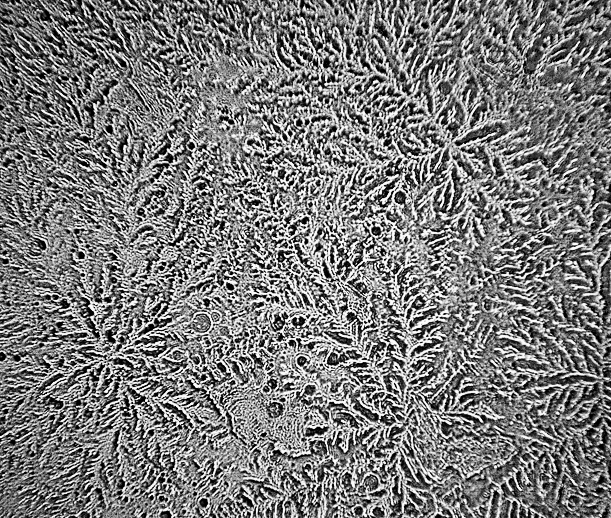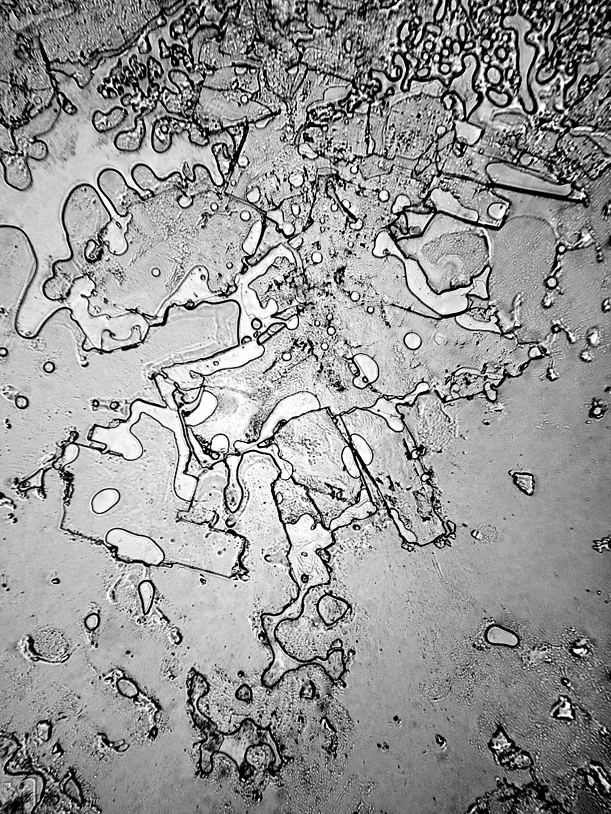

Photographer Rose-Lynn Fisher captures tears of grief, joy, laughter and irritation in extreme detail. Above: Tears of timeless reunion, photo © Rose-Lynn Fisher, courtesy of the artist and Craig Krull Gallery, Santa Monica, CA
In 2010, photographer Rose-Lynn Fisher published a book of remarkable images that captured the honeybee in an entirely new light. By using powerful scanning electron microscopes, she magnified a bee’s microscopic structures by hundreds or even thousands of times in size, revealing startling, abstract forms that are far too small to see with the naked eye.
Now, as part of a new project called “Topography of Tears,” she’s using microscopes to give us an unexpected view of another familiar subject: dried human tears.

Tears of change, photo © Rose-Lynn Fisher, courtesy of the artist and Craig Krull Gallery, Santa Monica, CA
“I started the project about five years ago, during a period of copious tears, amid lots of change and loss—so I had a surplus of raw material,” Fisher says. After the bee project and one in which she’d looked at a fragment of her own hip bone removed during surgery, she’d come to the realization that “everything we see in our lives is just the tip of the iceberg, visually,” she explains. “So I had this moment where I suddenly thought, ‘I wonder what a tear looks like up close?’”

Tears of ending and beginning, photo © Rose-Lynn Fisher, courtesy of the artist and Craig Krull Gallery, Santa Monica, CA
When she caught one of her own tears on a slide, dried it, and then peered at it through a standard light microscope, “It was really interesting. It looked like an aerial view, almost as if I was looking down at a landscape from a plane,” she says. “Eventually, I started wondering—would a tear of grief look any different than a tear of joy? And how would they compare to, say, an onion tear?”
This idle musing ended up launching a multi-year photography project in which Fisher collected, examined and photographed more than 100 tears from both herself an a handful of other volunteers, including a newborn baby.

Onion tears, photo © Rose-Lynn Fisher, courtesy of the artist and Craig Krull Gallery, Santa Monica, CA
Scientifically, tears are divided into three different types, based on their origin. Both tears of grief and joy are psychic tears, triggered by extreme emotions, whether positive or negative. Basal tears are released continuously in tiny quantities (on average, 0.75 to 1.1 grams over a 24-hour period) to keep the cornea lubricated. Reflex tears are secreted in response to an irritant, like dust, onion vapors or tear gas.
All tears contain a variety of biological substances (including oils, antibodies and enzymes) suspended in salt water, but as Fisher saw, tears from each of the different categories include distinct molecules as well. Emotional tears, for instance, have been found to contain protein-based hormones including the neurotransmitter leucine enkephalin, a natural painkiller that is released when the body is under stress.
Additionally, because the structures seen under the microscope are largely crystallized salt, the circumstances under which the tear dries can lead to radically dissimilar shapes and formations, so two psychic tears with the exact same chemical makeup can look very different up close. “There are so many variables—there’s the chemistry, the viscosity, the setting, the evaporation rate and the settings of the microscope,” Fisher says.

Tears of grief, photo © Rose-Lynn Fisher, courtesy of the artist and Craig Krull Gallery, Santa Monica, CA
As Fisher pored over the hundreds of dried tears, she began to see even more ways in which they resembled large-scale landscapes, or as she calls them, “aerial views of emotion terrain.”
“It’s amazing to me how the patterns of nature seem so similar, regardless of scale,” she says. “You can look at patterns of erosion that are etched into earth over thousands of years, and somehow they look very similar to the branched crystalline patterns of a dried tear that took less than a moment to form.”

Basal tears, photo © Rose-Lynn Fisher, courtesy of the artist and Craig Krull Gallery, Santa Monica, CA
Closely studying tears for so long has made Fisher think of them as far more than a salty liquid we discharge during difficult moments. “Tears are the medium of our most primal language in moments as unrelenting as death, as basic as hunger and as complex as a rite of passage,” she says. “It’s as though each one of our tears carries a microcosm of the collective human experience, like one drop of an ocean.”

Laughing tears, photo © Rose-Lynn Fisher, courtesy of the artist and Craig Krull Gallery, Santa Monica, CA
Original article and pictures take http://www.smithsonianmag.com/science-nature/the-microscopic-structures-of-dried-human-tears-180947766/?no-ist site
Комментариев нет:
Отправить комментарий